#1993 entertainment weekly
Explore tagged Tumblr posts
Text




1993 - Shannen Doherty portrayed by Davis Factor for the April 23, 1993 issue of Entertainment Weekly, featuring her on the cover.
Celebrity Hell
SHANNEN DOHERTY FEELS THE BURN
90210's fallen angel wants to heal her singed reputation. We show her (and other bedeviled stars) how to climb the stairway to heaven
By Lisa Schwartzaum.
THE CAREER CHALLENGES facing Shannen Doherty are these: How can she convince a skeptical public that she is not the tantrum-throwing prima donna, impoverished spendthrift, and out- of-control Hollywood headache that a barrage of reports in the higher and lower echelons of journalistic enterprise have made her out to be? How can the young star of Beverly Hills, 90210 redeem Brenda Walsh, her TV character, from the purgatory into which she has descended, wan and bereft of her broody boyfriend, Dylan McKay, and mocked by former fans who once loved wholesome Brenda but who now, at the end of the show's third season, hate her for her moody, goody-goody, expensively dressed ways? How can the small, pale, 22-year-old Southern Baptist from Memphis, Tenn., get everybody off her case?
For starters, she can settle in with a plate of french fries and a pack of Marlboro Lights and a cup of cappuccino and start confessing. About her money troubles. About how she knows she truly ought to stop smoking, since cancer runs in her family and the habit is turning her teeth yellow and will eventually make her fine skin look old. She can roast the old anti-Shannen chestnuts: that she slugged a woman in a bar; that she pitches fits to such an extent that she appeared as a joke in last week's Doonesbury. She can accept some blame.
Which is what she did – just as 90210 began its three-month spring hiatus this month and shortly before she left for a week's Hawaiian vacation with her live-in boyfriend, photo-studio owner Dean Factor, 28 (of the Max Factor cosmetics family), and with friend and 90210 classmate Tori Spelling, 19, and her beau, would-be actor Nick Savalas, 19. (Also planned for the break: starting work on Blindfold, a feature starring Judd Nelson; and attending a Grateful Dead concert.)

In fact, Shannen Doherty – who first found fame a decade ago on TV's Little House on the Prairie and went on to torment Winona Ryder as a bitchy high school snob in the 1989 film Heathers – talked and talked and talked, as if her career depended on it. And now we talk back, with a tailor-made image-rehab plan for the woman who inspired The I Hate Brenda Newsletter: (Will Brenda go to the University of Minesota and be written out of the series next season? Get real.)
If you can't pay cash, you can't afford it. On the one hand, Doherty admits to running up major bills (some reports put her debt at over $36,000). On the other hand, Doherty says she's paying it off – and insists she's no pauper. "I'm really fed up with people printing how much I make, especially when they get it wrong," she says. "I do not make $12,000 a week. I make a lot more money than $12,000 a week. But I'm in the highest tax bracket, and I have, you know, attorneys to pay for. And, granted, I have gone on shopping binges. When you're young and all you know is how much money you make a week, you don't necessarily start thinking about, you know, everything that comes out of it." Splitting the rent on the Beverly Hills Cape Cod-style house she now shares with Factor will cut expenses, but there's still $13,000 in dispute on her former house, which the landlord claims is owed as back rent and which Doherty claims represents the security deposit and lease option owed to her. "I didn't get thrown out of my house," she says defiantly. "Otherwise I wouldn't still have the keys." The case is currently being litigated. Limiting herself to one Mercedes instead of two will also save a bit, although reports that several cars have been repossessed is just exhaust, she says. She authorized the repo of a 500 SL she had leased for an ex-boyfriend ("a car that I wasn't even driving, and for somebody that I wasn't even going out with"). "If I had all these problems with my leasing company, why am I able to drive around in a Mercedes that I leased through them right now?" Doherty challenges. "If I had all these financial problems, there's absolutely no way in hell a bank would finance an $80,000 car."

2. The Donna Reed routine is refreshing. Keep it up. "My boyfriend and I are both sort of through with doing the night-club scene and partying and drinking," says Doherty, who has often been photographed carousing (usually with Spelling and accompanying escorts) at L.A.'s trendy club, Roxbury. "Clubbing was a big part of me, but I think it's because I was a little lost. I was young and under a lot of pressure and unhappy in my personal relationship. I don't have that problem anymore." She now describes an idyllic life of cooking chicken dinners with Factor and playing with her three dogs. Staying home should help her bottom line, too: After she made headlines like BRAWLING STARLET BUSTED last December for tangling at Roxbury with lesser-known actress Bonita Money (charges were eventually dropped), she says she lost at least three product-endorsement deals.
3. Shock your public: Say you're sorry! "I will grant that in the first season, I was not the most diplomatic person. But I did not throw temper tantrums. I went days and days and days without having a fit! Weeks!" says Doherty, with a laugh. "You know, right now I feel very much in control. Besides," she adds, more wishful, perhaps, than sure, "there are a lot of people out there who are getting very, very sick of Brenda bashing. People come up to me and go, like, 'We thought you'd be a bitch, we just wanted to come up and see if you were or weren't. And you're not." (The 90210 cast, having offered supportive comments in the past, is now tired of being asked about her; Doherty's recently fired publicist gives a terse "no comment" on her former client.)

4. Lighten up. That goes for Shannen and Brenda. Doherty is deeply steamed about the jokey one-shot I Hate Brenda Newsletter, which rode a wave of anti-Brenda/Shannen sentiment and showered considerable media attention on its two young creators. "It's ridiculous," she says, non-temper flaring, "that two girls, wherever they are, are so incredibly jealous of one person who happens to be on TV and are so desperate for publicity that they would create lies." But she can see how one might think Brenda is a pill. "The [90210] writers and I have had this conversation," she says. "Let's make her not quite so pathetic, let's have her mellow out.' And that is happening. You'll see Brenda spiritually become a little bit of a stronger person." (Of late, Brenda is looking spiritually subdued: humble in washed-out lipstick tones and more modestly dressed.)
5. Do not do that Playboy pictorial. She's thinking about it, negotiating with the magazine over how much of her body she'd expose. "They offered me a very large sum of money – over $300,000 – which I think anybody would have a very hard time turning down," she explains. "Besides, it might make people say, hey, she's not Brenda Walsh, she is Shannen Doherty, and she can play a lot older than 17 and high school." We repeat: Don't do it. If you pose, you will share that undistinguished honor with Mimi Rogers. La Toya Jackson. Joan Collins. Vanna White. And you'll never, ever win back Dylan McKay.
#shannen doherty#1993#1993 magazine#1993 article#1993 magazine article#1993 covergirl#1993 entertainment weekly#April 1993 entertainment weekly#davis factor#1993 davis factor#1993 davis factor EW#1993 Shannen Doherty#1990s#1990s shannen doherty#1990s magazine
7 notes
·
View notes
Text

Entertainment Weekly, 1993
#entertainment weekly#1993#1990s#seinfeld#jerry seinfeld#george costanza#jason alexander#elaine benes#julia louis dreyfus#kramer
60 notes
·
View notes
Note
Would you have a rolling stone subscription or any of your followers please? https://www.rollingstone.com/tv-movies/tv-movie-features/american-idol-lgbtq-contestants-1235027350/
It doesn't seem to be behind any sort of paywall for me, but I tend tp be cautious when reposting entire articles because blogs have been taken down for it before. Here's most of the worst of it, though. DM me if you want more and can't access it.

Travis wasn’t aware that he couldn’t carry a tune until his audition aired on TV a year later, in January 2006. Seated in the living room of the same halfway-house counselor who had driven him to the audition, he thought to himself, “God, I do suck.” But the realization was too late. His phone was already being blitzed with calls, first check-ins from friends and family members and then requests for interviews with People and Us Weekly. Soon after, Travis says the LGBTQ+ advocacy group GLAAD (which did not respond to a request for comment on this story) telephoned with the offer of taking action against Idol on his behalf. He thought to himself, “What the fuck did I just do?”
The public reaction to Travis’ off-key rendition of Whitney Houston’s 1993 single “Queen of the Night” is perhaps most succinctly summed up by the title of a YouTube video of the tryout: “American Idol Audition Boy or Girl.” Travis wore bell-bottom jeans in a feminine cut and a white tank top to his audition, pulling his wavy blonde hair behind his ears. Simon Cowell, infamously the harshest critic among the show’s original trio of judges, appeared horrified by the sight of Travis, his mouth agape. After Randy Jackson, the panel’s swing vote, kicked things off by asking the contestant to say “something interesting” about himself, Cowell asked, “That’s necessary, is it?” Cowell proceeded to stop Travis in the middle of his performance, which he called “confused.”
Travis has come a long way since Idol. After pivoting to a successful career in gay porn under the name Kirk Cummings, he retired from the adult entertainment industry and now works as a dog groomer, a profession he finds peaceful. But even 19 years later, he finds the footage of his audition tough to watch. As he left the studio in tears, editors added the theme music to The Crying Game, the 1992 film that uses the sight of a trans woman’s body to shock viewers. Today, Travis presents as male and uses masculine pronouns, but at the time of his audition, he had hoped to someday transition. He even had his new name picked out: Kelly. When he was incarcerated, others would try to dissuade him from pursuing a future as a trans person by telling him that it’s a “really hard life,” and Idol seemed to prove them all right.
“I thought, ‘Wow, if this is how my life’s going to be, then I don’t want any part of it,’” he says. “My experience is not the normal experience of a trans person, but because I had chosen to be on a television show, I saw the worst of it.”
Open cruelty is no longer part of the Idol brand, now that the show is in its second run on ABC after Fox canceled the long-running program in 2015. The series, like much of contemporary reality TV, now trades on positivity, and the annual tradition of airing bad auditions has long been discontinued. But during the height of its popularity in the 2000s, schadenfreude was a major part of the show’s appeal. While launching the careers of instant household names like Kelly Clarkson and Carrie Underwood, Idol was also the show where tens of millions of viewers watched Cowell tell Season Three contestant Heather Piccinini that she’s “ugly” when she sings and belittle Season Five’s Crystal Parizanski for overtanning; he even pulled Parizanski’s mother into the room to humiliate the contestant further. The show’s June 2002 premiere, in which Cowell advised a young woman to sue her vocal coach, made it clear what Idol would be selling.
That feed-them-to-the-lions approach made Idol the number-one program on TV six years running, the longest stretch at the top in broadcast history — but the show tended to prey on its most vulnerable contestants, perhaps unwittingly. Idol producers were forced to issue an apology after Cowell compared Season Six hopeful Kenneth Briggs, who has facial malformations due to Aarskog Syndrome, to a “bush baby.” Season Five’s Paula Goodspeed took her own life outside judge Paula Abdul’s home in 2008 after Cowell criticized the contestant’s metal braces following a performance of the Creedence Clearwater Revival/Ike and Tina Turner standard “Proud Mary.” Goodspeed was reportedly an obsessive stalker who changed her given name in tribute to Abdul, and the contest judge publicly criticized Idol’s producers for not doing more to protect her, saying she alerted them to Goodspeed’s behavior prior to the audition. (A spokesperson for the show did not comment on Abdul’s accusation at the time.)
Among those most targeted by Idol’s alleged abuses were anyone who was outside of the norm, as defined by the extremely narrow standards of Bush-era popular culture. This often included contestants who were experiencing mental health issues, individuals with disabilities, people of color, and plus-size singers like the late Mandisa Huntley, the Season Five contestant of whom Cowell infamously asked: “Do we have a bigger stage this year?” But Idol enjoyed a particularly contentious relationship with the queer contestants who hoped that the series would offer their big break into an unforgiving industry, many of whom had only started to come to an understanding of their LGBTQ+ identities. In another exchange condemned by GLAAD, Cowell told Travis’ fellow Season Five hopeful Charles Berry, who now is an out gay man, to shave off his beard and “wear a dress,” saying that he would make a “great female impersonator.”
Keith Beukelaer, whom Cowell famously called “the worst singer in the world,” knew immediately after his Season Two audition that it would end up being broadcast. “It’s something that I don’t know if I ever fully recovered from,” he says. “I remember it as if it was yesterday.” A devoted Madonna fan, he performed “Like a Virgin” in a green mock-turtleneck sweater, gyrating his body in sync with the song’s suggestive lyrics. Beukelaer has come to understand himself as having Asperger’s Syndrome, although he didn’t have the language for it at the time, and he came out as gay a few years after appearing on the program. He still struggles with the notoriety that his brief appearance on Idol brought, the decades of mockery that followed six minutes of air time.
Cowell did not return multiple requests for comment for this story. Neither did Jackson, longtime host Ryan Seacrest, or Idol creator Simon Fuller — who based the show off his own U.K. series Pop Idol, which aired from 2001 to 2003. But a source close to the production, who requested not to be named in this story, defended the show by affirming that “every single person who came on Idol, whatever their race, color, creed, or sexual preferences, was placed squarely in the firing line for Simon’s barbed critiques.”
[...]

What was a queer paradise for some, however, was a nightmare for others. Of those who spoke on the record, many say that Idol effectively forced them into the closet, and they believe it’s because the show was fearful that an openly queer contestant would alienate the show’s largely conservative viewership.
[...]
There was no rule saying that queer contestants couldn’t discuss their personal lives, but some singers say that Idol made it clear that some things were best kept secret. R.J. Helton, who uses they/them pronouns, went back into the closet and started dating a woman before they auditioned for Idol’s first season, hoping to make their family happy. Helton’s parents always envisioned that they would become a pastor or a Christian music artist, and when Helton’s boy band, the Soul Focus, went their separate ways, competing on Idol felt like a logical next step. Having recently broken things off with their fiancée, not wanting to live a lie, Helton began seeing their Idol stand-in during the season. Although they kept the romance a secret from producers, Helton says the other contestants knew. “None of them cared,” they say. “It was the first time that I felt accepted by a group of people.”
Idol producers never found out about the relationship, but the stakes were nonetheless made clear when executive producer Nigel Lythgoe, the show’s most influential creative voice, pulled Helton aside after seeing them exchange a friendly peck on the cheek with a male member of the crew. “Listen, we love you,” Helton says the producer told them. “We think you’re great, but let’s continue on the sweet side, with the Christian boy thing.” In their on-camera interviews and stage performances, Helton says they tried to tone down their natural ebullience, “butching it up” and staying as quiet as possible. A team of publicists, they recall, followed Helton everywhere “because they didn’t want me to break character.”
In an email to Rolling Stone, Lythgoe asserts that he “never stopped any contestant from coming out” and says he “never would have done so.” “I did work with a number of individuals who, sadly, were struggling with issues around coming out, and I provided feedback that was very common at the time: that they should let their talent do the talking and not allow others to denigrate them based on their personal lives,” he says. “If anyone was hurt by my advice on those issues, I can only apologize, but I only ever wanted to help and support the wonderful young people who competed on the first seasons of Idol, several of whom, tragically, were torn between a desire to live their truth openly and a great fear about how they would be treated on returning home by their families, by their communities, and even by God.”
Helton, now with the clarity of hindsight, wishes they’d had the confidence to present their full self to America. After being dropped from their record label following a 2006 interview in which they came out as gay, Helton recently came to the realization of their nonbinary identity. “I know it was a different generation, but there are parts of me that think: ‘If I could have worn a gorgeous evening gown with a full beard, I could have won,’” Helton says. When producers would tap them on the shoulder to remind them, “Hey, we don’t talk about this,” it made Helton scared of losing the only affirmation they’d ever had. “As a young person, that really plays with your psyche, especially when you’re not used to the spotlight, loads of fans, or the money. You just do what you’re told. I don’t know if that’s selling your soul to the devil, but it did feel like that. They lifted me up, put me on a pedestal, and told me that the pedestal will only be there as long as I play this part.”
Helton’s fellow Season One cast member Jim Verraros has spent years in therapy working to unlearn many of the unfortunate lessons he says Idol taught him, namely that it wasn’t OK to be himself. That education began with the Pygmalion-esque makeover given to the show’s aspiring superstars: Idol immediately traded in his nerdy aesthetic — wiry glasses and jean jackets with the collar popped — for a generic rock look, sleeveless vests with leather cuff bracelets. He got contacts, lowered his voice half an octave, and put away what he calls the “theatrical and stage part of me that comes also from having deaf parents and being expressive.” “It comes at a cost,” he says. “When you’re told that you aren’t enough — or that this version of you doesn’t work — you spend a big part of your life taking parts away from you so that you can achieve those dreams.”
Although Verraros made the Top 10 of his season, he struggled with the role created for him, and the miscasting of a nebbishy gay Midwestern boy as a conservative-friendly heartthrob led to friction with the show’s creative team. Former co-host Brian Dunkleman, who emceed Idol’s first season alongside Ryan Seacrest, says he overheard Cowell and Randy Jackson discussing plans to directly target Verraros, hoping to get a strong reaction out of him that they could film. “We’re gonna nail Jim,” he recalls the judges saying as they were having coffee in an Idol break room. Cowell tended to reserve his harshest critiques of the show’s inaugural cast for Verraros, and following that discussion, he told the contestant live on air, “I think if you win this competition, we would have failed.”
Idol did get the emotional reaction it sought from Verraros in a scene that ultimately landed on the cutting-room floor. Prior to the announcement of the season’s Top 10 finalists, Dunkleman says that Cowell informed the contestants they would be using the “judges’ veto��� to oust one of them from the show. “Jim, you’re out of the competition,” Cowell told Verraros, prompting the young singer to burst into tears. (That’s when Dunkleman recalls that Lythgoe came over and instructed everyone to sing a modified version of the Monkees’ “Daydream Believer” to brighten Verraros’ spirits. “Cheer up, sleepy Jim,” fellow contestants sang together in unison.) For reasons that are unclear, Lythgoe opted to backtrack on the judges’ decision, Dunkleman says, allowing Verraros to move forward to the next round after all. “Later that night, I was at dinner and I got a pretty frantic message from Nigel saying, ‘Look, there’s been a change. Jim is back in the competition. Just please don’t tell anybody about anything that happened today,’” Dunkleman remembers. “And then the next night he made the Top 10.”

Those incidents, Dunkleman adds, played a major role in his decision to part ways with Idol, calling the program “evil.” He also recalls that a judging panel needed to be refilmed so Cowell could call Helton a “loser” instead of a “monkey.” “That’s what it was,” he says of Idol. “It was about how mean they were. It was about how shocking this was and how much they were making fun of these singers.” He isn’t sure, though, why the show singled Helton and Verraros out in particular. “Is it conscious targeting or is it subconscious? That kind of undertone, maybe they weren’t even aware of it.”
[...]
AMERICAN IDOL often strained to fit queer contestants into an instantly recognizable mold that producers could market for the widest possible audience. Simon Cowell declared that he would quit the program if Sanjaya Malakar, an affable Season Six hopeful with a perpetual smile, won the competition. Malakar, who is half Bengali and performed with the Hawaii Children’s Theater during his time living in Kauai, was unlike any singer the show had ever seen. He was earnest and goofy, striding up to the judges’ table to dance with Paula Abdul during a performance of Irving Berlin’s “Cheek to Cheek.” He also straddled the lines of gender, flat-ironing his chameleonic locks for a winsome cover of John Mayer’s “Waiting on the World To Change.” After weeks of all but begging viewers to vote Malakar off the show, Cowell commented regarding the latter song: “Maybe it’s your hair that’s keeping you in. I don’t know.”
Malakar came out as bisexual many years after Idol was over, finding himself after taking a job at a karaoke bar in New York where he found freedom in anonymity. What was hardest for Malakar to navigate, he says, was not the constant scrutiny from Idol’s judges but the vitriolic reaction from fans. A MySpace blogger vowed to stop eating until Malakar was sent home, although the contestant outlasted the hunger strike, which ceased after 16 days. The website Vote for the Worst, which urged fans to subvert the Idol system by keeping on its quirkiest and most divisive contestants, took up Malakar as a personal cause.
Looking back, Malakar believes that it’s the ambiguity of how he presented that bothered people so much. The judges and viewers just couldn’t figure him out because, as a 17-year-old kid who hadn’t graduated high school yet, he hadn’t figured himself out. “There was no way to really understand how to define me,” he says. “They didn’t know what culture I was. They didn’t know what sexuality I was. They didn’t know what genre I was. I was this anomaly that made people uncomfortable.”
The queer singers who had the most painful time being reshaped by the Idol system were those who stood out the most, whether they were flamboyant and over-the-top in their performance style, like Malakar, or their gender presentation skewed toward the effeminate. Season Eight runner-up Adam Lambert — who declined to speak for this story, citing his shooting schedule for The Voice Australia, on which he is a judge — has said that queer contestants who didn’t have the ability to hide were used by Idol as “comic relief.” “Anytime someone came on the show that was perceived to be gay or it was obvious enough that they were gay, they were a joke,” he remarked to the British music magazine NME in a 2018 interview. He added: “To be fair, some of them weren’t great singers, but there were a couple of really good singers that came on. And they weren’t taken seriously.”

To illustrate his point, Lambert noted the example of Adore Delano from Seasons Six and Seven, who would later contend on the reality competition show RuPaul’s Drag Race. Delano declined to participate in this story, but in a 2023 Instagram video publicly announcing her transition, she said that she went back into the closet to compete on Idol. Appearing on the show led her to suppress her transness in order to present herself as “something that was so uncomfortable,” she recalled. And yet her effervescent femininity couldn’t be contained: During her second appearance on Idol, she performed a sassy rendition of “Jailhouse Rock” by Elvis Presley that Cowell deemed “hideous” and “verging on the grotesque.” Delano was ultimately eliminated from the Top 16 after a performance of Soft Cell’s queer anthem “Tainted Love” that Cowell declared “absolutely useless.” She dyed her silky hair purple for the number.
Like Delano, Atlas Marshall auditioned for Idol twice, making it to the Top 36 in Season Eight and then trying out again for Season 16. Both experiences were extremely fraught. Following a performance of Meat Loaf’s “I’d Do Anything For Love (But I Won’t Do That)” during her first appearance on the show, Cowell looked at Marshall and remarked, “I think you probably would.” Even as a guileless 18-year-old with frosted emo bangs and angel-bite piercings, Marshall realized it was a “loaded comment.” “The joke around that song is that it’s about anal sex,” she says. After the audience booed Cowell’s remark, Ryan Seacrest, then the show’s sole emcee, invited Marshall to come sit on the judge’s lap, but Paula Abdul intervened and beckoned the contestant to rest on hers instead. Marshall was voted off Idol the next day.
[...] Marshall’s mother, who recently passed away, was a lesbian, and she raised her child in a queer household where it was OK to be “open, flamboyant, and fabulous,” as Marshall recalls. Being taught by Idol that the outside world might mock the parts of herself she was taught to embrace was a rude awakening. “For so long, there was a lot of shame around it,” she says of her first Idol experience. “I felt gross. I didn’t like myself.”
[...]
While the team behind Idol’s current iteration did not offer a comment on the record, the source close to the Fox production contests the idea that the show stopped contestants from expressing their most authentic selves, while adding that “coming out might have damaged certain contestants’ chances for success.” “No one ever prevented anyone from doing so, but there was often a sense — right or wrong — that it would be better if the American public’s vote was based more on their judgment about the performers’ talent rather than their sexual orientations,” the source says.
[...]
Although it would feel convenient to point the finger solely at Idol, the show at its peak reflected America’s culture as much as it defined it. When the series premiered in 2002, polling from Gallup showed that 43 percent of the U.S. populace still thought homosexuality should be illegal; Lawrence v. Texas, the Supreme Court ruling that struck down sodomy laws in the 14 states where gay sex was still illegal, wouldn’t be issued for another year. A majority of Americans wouldn’t support the right of same-sex couples to marry until 2011, during Idol’s tenth season on the air. That was also, coincidentally, the first season not to feature either Paula Abdul or Simon Cowell on the judges panel. Abdul, hailed by sources as a major supporter of queer contestants behind the scenes, parted ways with the program after Season Eight. Cowell left the following year to launch the U.S. spinoff of The X Factor, the British singing competition he created in 2004.
[...]
For all the troubles that some queer contestants say they had on the show, many argue that Idol’s missteps paled in comparison to how cruelly they were treated by the rest of the media, the music industry, and even America at large. Idol voters eliminated Season Seven’s David Hernandez the week after an Associated Press story revealed that he had previously worked as a dancer at a Arizona strip club that catered to a “mostly male” clientele. By that time, photos that allegedly showed Hernandez bartending at a gay nightclub had already been published on Vote for the Worst, although Hernandez says the pictures weren’t even of him. He says that Idol was already well aware of his work history by the time the reports surfaced, as he disclosed the information in the extensive questionnaire the show required contestants to complete; spanning over 100 pages in length, it also asked singers to name their past sexual and romantic partners.

[...]
The media persecution of queer Idol contestants was so de rigueur during the show’s imperial era that few even questioned it. Jim Verraros’ coming out in 2002 prompted a two-page spread in the Globe, a U.S. supermarket tabloid, asking: “Who’s Next?” Chatter surrounding Adam Lambert’s sexuality made the New York Times after photos circulated of the singer, eyes covered in makeup and glitter all over his face, locking lips with another man. Following the Season Two finale, Clay Aiken says that the first question that he was ever asked by a reporter was: “Are you gay?” He wouldn’t formally come out until a 2008 People magazine cover story coinciding with the birth of his son, and for years, he says, confirmation of his sexual orientation “was the only thing that anybody in the press wanted” from him. “I never did an interview where somebody was not trying to ask me if I was gay,” he says, later adding: “Everybody wanted to be the one who got it.”
Aiken says that speculation regarding his sexuality reached such a fever pitch that, for a time, he stopped leaving his house. Even then, there was no hiding from it: “If I heard anybody setting up a gay joke on a sitcom or a late-night show, I held my breath because I knew my name was coming. Eighty percent of the time I was right.” The topic was a frequent punchline of late-night host Jimmy Kimmel, who frequently booked Aiken to appear on his show, and comedian Kathy Griffin spent a full 15 minutes discussing Aiken’s sexuality in a 2005 stand-up special on Bravo. “I do find him to allegedly be the gayest man in the free world,” she said in the routine, calling him “Gayken” to hearty applause from the crowd. Even two years after he had actually come out, a Season Eight episode of Family Guy saw Stewie, during a parody of Family Feud, being asked to name a “popular fruit” and responding: “Clay Aiken.” “I laugh at them now,” he says of the jokes, noting that he calls Griffin a friend. “I find them hilarious now, but at the time, it hurt a lot.”
Full article here
32 notes
·
View notes
Text



Michelle Pfeiffer for Entertainment Weekly, January 29, 1993
#Michelle Pfeiffer#throwbackblr#90sedit#dailyactresses#flawlessbeautyqueens#dailywomen#actresses#photography#my edits
128 notes
·
View notes
Text




Queen Latifah photographed by F. Scott Schafer for Entertainment Weekly, 1993
#queen latifah#rapper#model#photoshoot#fashion#style#famous#celebrity#hair#makeup#magazine#actress#actor#black woman#black women#black beauty#black model#black girl magic#90s#1993#entertainment weekly
43 notes
·
View notes
Text
So . . . I was sent these.
A couple of you know I used to have a Beetlejuice x Lydia blog. Used to be into the fandom big time, since the movie first opened in 1988. Then, for reasons I won't get into, I lost interest in all things Beej.
But some people still read my Beej fics on AO3. And one of them sent me these photos from Beetlejuice 2. They also sent me the link to the article they appeared in.
So for you few Beetlebabes who still Follow me -- you know who you are -- here's the article.
“Beetlejuice Beetlejuice”... Beetlejuice returns in first look at Michael Keaton, Winona Ryder
Nick Romano
Wed, March 20, 2024 at 9:00 AM CDT
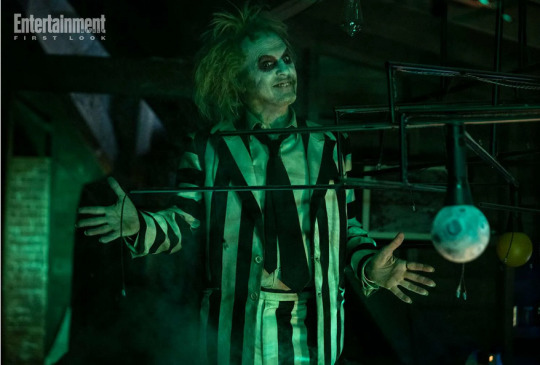
It's been 36 years, but once again, the juice is loose.
After reprising Batman in last year's The Flash, Michael Keaton returns to another iconic role in Entertainment Weekly's exclusive first look at Beetlejuice Beetlejuice, the sequel to director Tim Burton's cult hit.
Winona Ryder and Catherine O'Hara also reprise their roles as Lydia and Delia Deetz, respectively, while Burton's Wednesday star Jenna Ortega plays Lydia's daughter Astrid, and The Leftovers star Justin Theroux plays Rory. Further details on Rory remain under wraps for now — unlike the titular "bio-exorcist."
The original Beetlejuice (1988) followed the recently deceased Barbara and Adam Maitland (Geena Davis, Alec Baldwin), who enlist the aid of the mischievous demon Beetlejuice/Betelgeuse (Keaton), to expel the current living residents of their home, the Deetz family. All hell, subsequently, breaks loose.
The sequel picks up decades later with a death in the family. "That's all I will say," Burton tells EW in an interview. "There's something that happens that sets things in motion." Could that be the death of Lydia's father, Charles Deetz (Jeffrey Jones)? The director plays coy: "We'll see." One thing's for sure, Beetlejuice comes back into play.
Burton describes getting Keaton back in the classic costume and makeup as "a weird out-of-body experience."
"He just got back into it," the filmmaker behind 1989's Batman (also starring Keaton) and 1993's The Nightmare Before Christmas recalls. "It was kind of scary for somebody who was maybe not that overly interested in doing it. It was such a beautiful thing for me to see all the cast, but he, sort of like demon possession, just went right back into it."
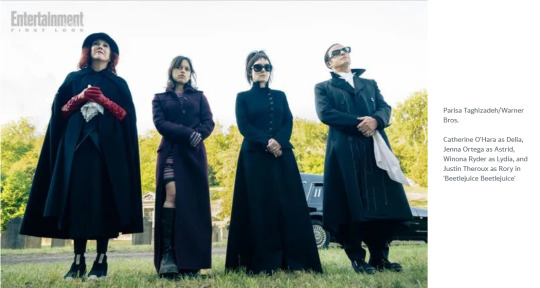
Burton says he and Keaton have talked about a sequel on and off over the years. "Unless it felt right, he had no burning desire to do it," the director recalls. "I think we all felt the same way. It only made sense if it had an emotional hook."
Many concepts were floated around, some dating all the way back to the '80s, including a treatment set in Hawaii. "We talked about lots of different things," Burton says. "That was early on when we were going, Beetlejuice and the Haunted Mansion, Beetlejuice Goes West, whatever. Lots of things came up."
What they needed, however, was time. His actors, including Ryder and O'Hara, had all moved on to other projects after the original came out, and "nobody," Burton notes, "was really pushing for it." The filmmaker also admits he didn't initially (and still doesn't to some degree) understand the success of the first film, so he wasn't motivated to move forward with an idea that didn't excite him.
The hook he was looking for, as it turns out, revolves around Ryder's Lydia and bringing together three generations of Deetz women, including O'Hara's Delia and Ortega's Astrid. "I so identified with the Lydia character, but then you get to all these years later, and you take your own journey, going from cool teenager to lame adult, back and forth again," he explains. "That made it emotional, gave it a foundation. So that was the thing that really truly got me into it."
Other details on the film itself are being kept secret for now, other than the presence of Monica Bellucci (Spectre), Arthur Conti (House of the Dragon), and Willem Dafoe (Poor Things) among the cast. (Dafoe previously disclosed his role as a B-movie action star who died and became a police officer in the Afterlife.) Burton feels "a bit jinx-y" about revealing such things, given that he's still shaping the movie in the editing phase. But he does confirm he'll be using stop-motion animation to bring a lot of the classic Beetlejuice effects to the screen. "It needed a back-to-basics, handmade quality," he says. "It reenergized why I love making movies."
And what about that title? Beetlejuice Beetlejuice. "It's been, what? Thirty-five years. So it didn't feel like Beetlejuice 2 to me," Burton says. "It didn't feel like that kind of a movie. The other one I thought of, because one of my favorite Dracula movies is Dracula A.D. 1972, was Beetlejuice 2024 A.D. But this was a nice simple one."
Just don't say the name one more time, or you risk summoning the man himself.
Beetlejuice Beetlejuice will hit theaters on Sept. 6.
*~*~*~*~*~*~*~*~*~*~*~*~*~*~*~*~*~*~*~*~*~*~*~*~*~*~*~*
Addendum: Was sent the link to this, too.
I'm . . . fearfully optimistic . . . .
youtube
20 notes
·
View notes
Text

Ben Affleck and Matt Damon: Faces of the Oscars
They successfully turned a high-tech thriller into a tearjerker, and struck a box office heart of gold — but the real payoff may come on Oscar night
By Rebecca Ascher-Walsh for Entertainment Weekly (13 February 1998)
[NOTE: The full transcript of the article, as retrieved from the Entertainment Weekly website, is under the cut. It does seem surprisingly short to me, so I don't know if it is in its complete form as presented in the original issue. If anyone has any information on this, it would be most welcome!]
Good Will Hunting
Math prodigy Will Hunting, on a job interview with NASA, is given a test code to crack. He quickly spots an evil scheme: NASA and the FBI have set him up with a real code, which, once solved, could cause mass destruction. Hunting recruits his best friends and understanding shrink to hatch a plan, beat the government, and save the day.
This is not, most certainly, the subtle, warm-the-cockles-of-your-heart Good Will Hunting that has propelled cowriters, actors, and childhood best friends Matt Damon and Ben Affleck onto Hollywood’s most-wanted list, into the hearts of American audiences, and toward the Oscar podium. And the tortuous path Affleck and Damon were forced to navigate in order to transform the movie from a high-tech conspiracy thriller to an intimate character study is one of the most dramatic stories of the Oscar season.
After five years of knocking, Damon, 27, and Affleck, 25, have been admitted to the Movie Hall of Fame so suddenly that it’s a little disconcerting. A few weeks ago, an 80-year-old woman walked past the Manhattan set of Miramax’s Rounders, in which Damon plays a card shark, and — upon learning who the star was — exclaimed in wonder, “Matt Damon, the sex symbol?!” And when Affleck — in L.A. to film the summer blockbuster-in-waiting Armageddon with Bruce Willis — went to the Disney cafeteria and signed for his lunch because he’d forgotten his wallet, he learned the next day on a television gossip show that he had, in fact, pitched a fit and demanded a free meal. “It worried me,” Affleck says. “I haven’t trashed a hotel room yet, but yesterday I leaned back in my chair at the Four Seasons and it kind of snapped. What will they think?”
What they’ll think is that Good Will Hunting‘s odyssey is a classic Hollywood-in-the-’90s Cinderella story, the kind that ends with the prospect of Academy Awards and surprisingly good box office. Which isn’t far from the truth, if the evil stepmother becomes a studio, and Prince Charming is redrawn to look like (gulp) Harvey Weinstein.
Affleck — who refers to his partner and himself as “the Milli Vanilli of screenwriters” — and Damon began to work on Good Will Hunting in 1993, basing the story on a one-act play Damon had written at Harvard (he left before completing his studies). They drew from their own life growing up in Boston, where they were introduced by their mothers, both teachers, 17 years ago. “We’re pretty inseparable, in terms of our experiences,” Damon says. “We look at things in exactly the same way.” While they wrote, Damon says, “it wasn’t like someone was good at structure and someone at dialogue. The only difference between us is Ben can type.”
Neither, however, can edit. “We must have written 1,500 pages,” Damon says. “We had Will Goes to the Zoo episodes.” Within months, they settled on a script combining a friendship adventure with a “banana in the tailpipe” plot, as Affleck described the then-thrill-a-minute NASA caper. The characters of Will (Damon), a down-and-out boy genius, and his best friend Chuckie (Affleck), a construction worker, were already in place. But instead of the mentor/professor eventually played by Stellan Skarsgard, imagine a nefarious FBI agent attempting to corrupt Will, and instead of boy-meets-therapist bonding, picture a climax with world peace at stake.
That may have been a tall order for what Damon and Affleck envisioned as an independently financed $2 million project — and in November 1994, when Castle Rock won a bidding war for the script, director Rob Reiner, a partner in the studio, told them to drop the adventure angle and focus on the relationships. “It was a scary moment,” says coproducer Chris Moore. “We started [all over again] with 63 pages and made it a character story.”
#matt damon#ben affleck#matt & ben#good will hunting#rounders#armageddon#on fame#on meeting each other#on friendship#on writing together#magazine article#quote#photo#entertainment weekly#1998#originals
10 notes
·
View notes
Text
Nancy Savoca
youtube
Director and screenwriter Nancy Savoca was born in New York City in 1959. Savoca's first feature film, True Love, received the Grand Jury Prize at the Sundance Film Festival, and was named one of the "50 Greatest Independent Films of All Time" by Entertainment Weekly. Her 1993 film, Household Saints, was nominated for best screenplay at the Independent Spirit Awards. Savoca also co-wrote and co-directed If These Walls Could Talk, an anthology film about women's experiences with abortion in three different eras. The film was nominated for multiple Golden Globes and Emmy Awards.
5 notes
·
View notes
Text
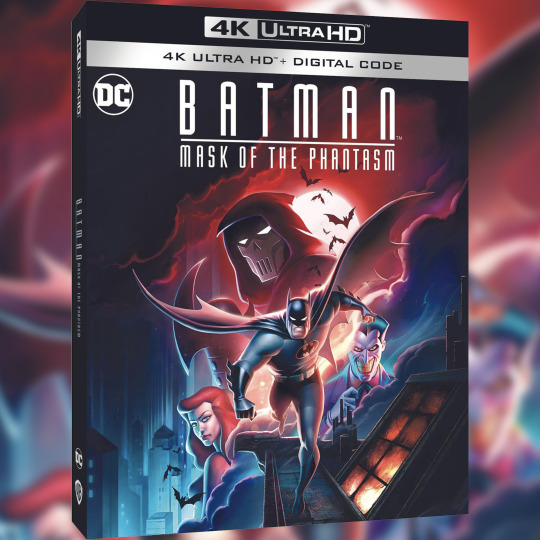
‘Batman: Mask of the Phantasm' 4K Blu-Ray
Celebrate the 30th anniversary of the most universally acclaimed film in the Dark Knight’s legendary cinematic history when the newly-remastered animated movie Batman: Mask of the Phantasm, comes to 4K Ultra HD for the very first time. From Warner Bros. Discovery Home Entertainment, the film will be available to purchase on 4K Ultra HD on September 12, 2023.

The release will also include an all-new featurette Kevin Conroy: I Am The Knight, which takes a look at the legacy of Kevin Conroy, who voiced Batman for 30 years in film, television, video games and more.
Rooted in DC’s acclaimed Batman: The Animated Series and released theatrically on Christmas Day 1993, Batman: Mask of the Phantasm has not only been ranked by Time magazine as one of the 10 best Super Hero movies ever, but is also arguably the core fans’ all-time favorite Batman film. The movie has been rated at the top of the Dark Knight film franchise by such popular entertainment media as Empire, Screenrant and Paste. And in the ultimate mainstream salute for its time, Gene Siskel & Robert Ebert didn’t initially review the film during its theatrical release, but later dedicated a portion of their At The Movies weekly TV series to pay compliment to the film – and voice their regret for not giving it the attention it deserved during its original run – when Batman: Mask of the Phantasm was distributed for home entertainment.
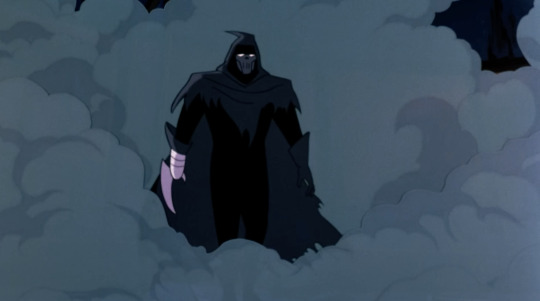
The 4K HDR/SDR remaster of Batman: Mask of the Phantasm was sourced from the 1993 Original Cut Camera Negative and was scanned at 4K resolution. Digital restoration was applied to the 4K scans to remove dirt, scratches and additional anomalies, but special care was given to not touch the film grain or the animation cel dirt that was part of the original artwork. This is the first time since its theatrical release that it is presented in its 1.85 aspect ratio. The original 2.0 mix and the 5.1 tracks were remastered to remove or improve defects such as pops, ticks, dropouts and distortion.
The animated film features an all-star cast headed by the quintessential voice of Batman, Kevin Conroy, alongside Dana Delany (Desperate Housewives, China Beach) as Bruce Wayne’s love interest, Andrea Beaumont, Mark Hamill (Star Wars franchise) as the Joker, Stacy Keach (Nebraska, Prison Break, Mike Hammer) as Phantasm/Carl Beaumont, Abe Vigoda (Barney Miller, The Godfather) as Salvatore Valestra, Efrem Zimbalist Jr. (The F.B.I.) as Alfred, Hart Bochner (Die Hard) as Arthur Reeves, Bob Hastings (McHale’s Navy, The Poseidon Adventure) as Commissioner Gordon, Robert Costanzo (Forget Paris, City Slickers) as Detective Bullock, Dick Miller (Gremlins, The Terminator) as Chuckie Sol, and John P. Ryan (The Right Stuff) as Buzz Bronski. Additional voices included Pat Musick, Marilu Henner, Neil Ross, Ed Gilbert, Jeff Bennett, Jane Downs, Vernee Watson, Charles Howerton, Thom Pinto and Peter Renaday.
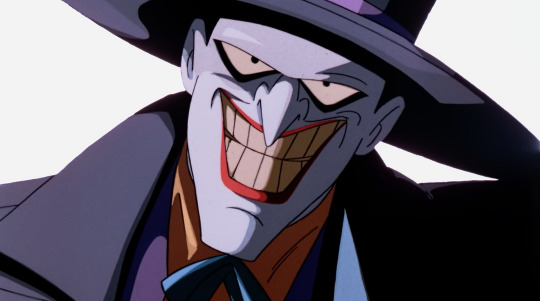
The Batman: Mask of the Phantasm filmmaking team is composed of the award-winning core group behind Batman: The Animated Series. Eric Radomski and Bruce Timm directed the film from a screenplay by Alan Burnett, Paul Dini, Martin Pasko and Michael Reaves, based on a story by Burnett.
Batman: Mask of the Phantasm will be available on September 12, 2023 to purchase Digitally from Amazon Prime Video, AppleTV, Google Play, Vudu and more. 4K Ultra HD Discs will be available to purchase online and in-store at major retailers. Pre-order your copy now.
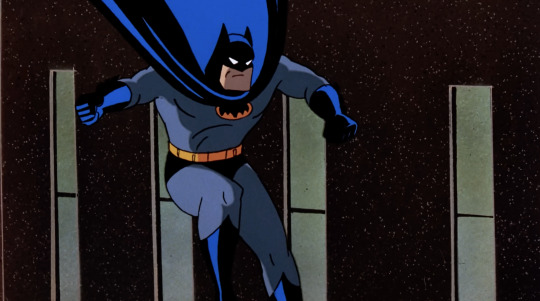
SYNOPSIS:
Batman: Mask of the Phantasm opens with the city's most feared gangsters being systematically eliminated, and assumed blame falling on the Caped Crusader. But prowling the Gotham night is a shadowy new villain, the Phantasm, a sinister figure with some link to Batman's past. Can the Dark Knight elude the police, capture the Phantasm and clear his own name? Unmasking the Phantasm is just one of the twists in this dazzling animated feature, which provides new revelations about Batman's past, his archrival the Joker, and Batman's most grueling battle ever - the choice between his love for a beautiful woman and his vow to be the defender of right.
SPECIAL FEATURES INCLUDE*:
Kevin Conroy: I Am The Knight (New Featurette) – For 30 years, Kevin Conroy defined Batman for multiple generations using only his voice, best exemplified in the landmark film Batman: Mask of the Phantasm. Conroy passed away in November 2022, but his legacy lives on in 15 films, nearly 400 episodes of animated television series, a dozen video games, and as a live-action Bruce Wayne in the Arrowverse’s 2019-2020 “Crisis on Infinite Earths” crossover event. Several of Conroy’s contemporaries – including animation legend Bruce Timm, Batman producer Michael Uslan and revered voice actress Tara Strong – pay tribute to the star who remains the Dark Knight for millions of Batfans.
Bonus episode of Justice League: Unlimited featuring a cameo from Phantasm.
*Special features are not available in 4K Ultra HD.
The Batman legend continues in this story that tells of Batman's most difficult battle, as well as his confrontation with a mysterious killer, who holds the key to Batman's secret past.
youtube
MPAA rating : PG (Parental Guidance Suggested)
Item Weight : 3.52 Ounces
Director : Bruce Timm, Eric Radomski
Run time : 1 hour and 16 minutes
Release date : September 12, 2023
Actors : Kevin Conroy, Dana Delany
Subtitles: : English
Studio : Studio Distribution Services
ASIN : B0CBQPHLG9
Country of Origin : USA
Number of discs : 1
Preorder now.

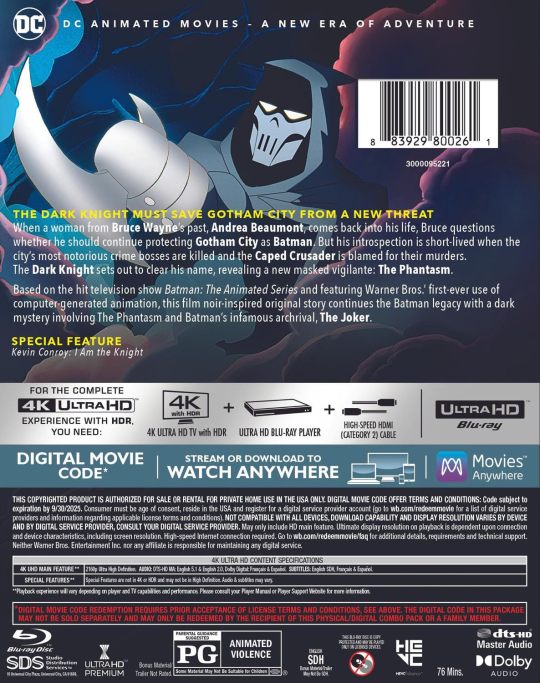

28 notes
·
View notes
Text

Seinfeld Fab Four Beatles inspired cover Entertainment Weekly #165 4/9/1993
2 notes
·
View notes
Text
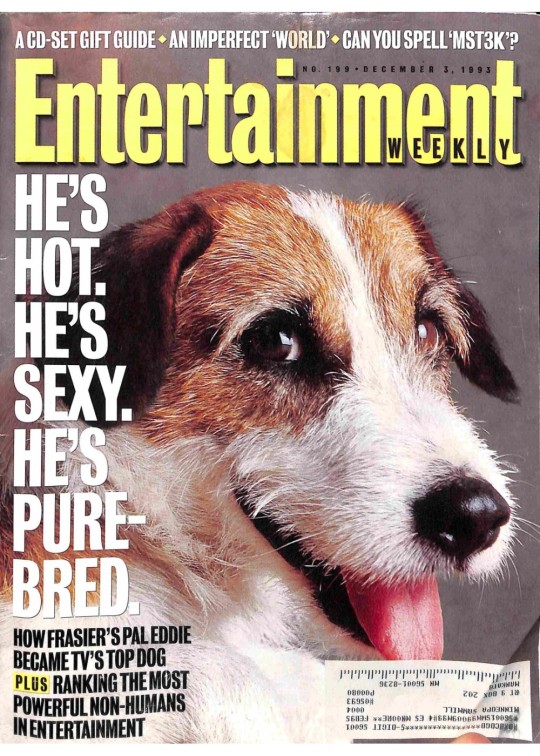
TIL Moose (the actor who played Eddie on Frasier) was on the cover of Entertainment Weekly in December of 1993.
52 notes
·
View notes
Text






















1993 - Shannen Doherty portrayed by Davis Factor for the April 23, 1993 issue of Entertainment Weekly, featuring her on the cover.
I love how she always took the bad things with a great sense of humour...
#shannen doherty#1993 davis factor#1993 davis factor EW#photoshots#1993 photoshots#1993 shannen doherty#1990s#1990s shannen doherty#1990s photoshots
7 notes
·
View notes
Text
Marlene Dietrich - The Queer Icon












Marie Magdalene "Marlene" Dietrich (born in Berlin, Germany on 27 December 1901) was a German-born actress who often blurred the feminine and masculine, making her "The Queer Icon."
Dietrich's earliest appearances were as a chorus girl in 1922. Making film history, she was cast in Germany’s first talkie The Blue Angel (1930) by director Josef von Sternberg. With the success of the movie, von Sternberg took her to Hollywood under contract to Paramount Pictures. She soon had hits like Morocco (1930) and Shanghai Express (1932).
When war broke, she set up a fund to help Jews and dissidents and toured extensively for the allied effort. After the war, she limited her cinematic life.
In 1953, Dietrich appeared live at Sahara Hotel in Las Vegas. This was so successful that she also appeared at Café de Paris in London and Broadway.
She continued to tour as a marquee performer until 1975, when she fell onstage. She spent her final years mostly bedridden, passing away at 90 in her Paris flat from kidney failure.
Legacy:
Nominated for the Academy Award for Best Actress for Morocco (1930) and a Golden Globe Best Actress for Witness for the Prosecution (1958)
Received a Special David at the David di Donatello Awards for Judgment at Nuremberg (1961)
Given a Special Tony Award in 1968
Received German Film Awards Honorary Award in 1980
Is the namesake for asteroid 1010 Marlene in 1923
Inspired the Marlene pants in 1932
Has a Mercedes-Benz model, the 500K Marlene, named after her in 1936
Received the Presidential Medal of Freedom in 1947, the Commander of the Legion of Honour in 1950 and Commander of the Order of Arts and Letters in 1983 from France, the Order of Leopold in 1965 from Belgium, and Medal of Valor of the State of Israel in 1965
Published an autobiography Nehmt nur mein Leben in 1979
Granted the Council of Fashion Designers of America Lifetime Achievement Award in 1986
Honored with a plaque at her birth site in 1992 and became an honorary Berlin citizen in 2002
Has a permanent exhibit at Deutsche Kinemathek, the Marlene Dietrich Collection Berlin, since 1993
Ranked #60 in Empire's 100 Sexiest Stars in Film History in 1995
Honored with street names: the Marlene-Dietrich-Straße in Munich, Dusseldorf, Weimar, Ingolstadt, and Neu-Ulm, the Marlene-Dietrich-Allee in Potsdam, the Marlene-Dietrich-Platz in Berlin in 1997, and Place Marlène-Dietrich in Paris in 2002
Commemorated by Deutsche Post with a stamp in 1997
Listed 43rd in Entertainment Weekly's 100 Greatest Movie Stars of All Time in 1998
Depicted in a musical, Marlene on the West End in 1997 and Broadway in 1999, and a biopic, Marlene (2000)
Named 9th-greatest female star of classic Hollywood cinema in 1999 by the American Film Institute
Inducted in the Online Film and Television Association Hall of Fame in 2003
Honored by Montblanc with a fountain pen in 2007 and by Swarovski with a dress in 2017
Awarded a star in Berlin's Boulevard der Stars in 2010
Honored with a Google Doodle on her 116th birthday in 2017
Honored as Turner Classic Movies Star of the Month for May 2018
Featured in songs, including Suzanne Vega's "Marlene on the Wall" (1985), Peter Murphy's "Marlene Dietrich's Favourite Poem" (1989), Black Midi's "Marlene Dietrich" (2021)
Depicted onstage in Marlène Dietrich, The Blue Angel's White Nights in 2017 at Théâtre Trévise and Marlene in Hollywood in 2023 at Theater Lindenhof
Featured in exhibits, such as "Marlene Dietrich, Creation of a Myth" at Palais Galliera in 2003, "Marlene Dietrich: Dressed for the Image" at National Portrait Gallery in 2017, "Play the Part: Marlene Dietrich" at International Center of Photography in 2023
Is a muse for designers, including Vivienne Westwood, Thierry Mugler, Jason Wu, Max Mara, David Koma, and Dior
Has a star on the Hollywood Walk of Fame at 6400 Hollywood Boulevard for motion picture

#Marlene Dietrich#Blonde Venue#Blue Angel#Silent Films#Silent Movies#Silent Era#Silent Film Stars#Golden Age of Hollywood#Classic Hollywood#Film Classics#Classic Films#Old Hollywood#Vintage Hollywood#Hollywood#Movie Star#Hollywood Walk of Fame#Walk of Fame#Movie Legends#Actress#hollywood actresses#hollywood icons#hollywood legend#movie stars#1900s
2 notes
·
View notes
Text
youtube
MTV News Breaking News on Kurt Cobain's Death
On April 5, 1994 Kurt Donald Cobain died at age 27. His body was not found until April 8 when an electrician went to the home and discovered the body. Hard to believe its been 30 years.

Cobain at Nirvana's MTV Unplugged taping
I’ve talked before about April 5 in Seattle music history here. I’ve talked even more times about Cobain and Nirvana. Of all celebrity deaths, that is one that had a big impact on me. I had just started high school in the Fall of 1991 when Nirvana’s Nevermind was released and their music was the soundtrack to high school for me. Skip ahead to April 8. I was at an after-school job and the radio was on. It was WBCN I believe. The DJ reported that a dead body had been found at the home of Kurt Cobain in Seattle. No more information was given. It wasn’t clear if Kurt was gone or if someone had died on the property. That night, my step-sister was at our house and she asked me “are you in mourning?”, I didn’t know what she meant at first, so she followed up, “Kurt Cobain. He’s dead.”. I didn’t want to believe it. So I immediately went to my room and turned on WFNX. They were playing Nirvana all night and taking calls from listeners (’FNX were early supporters of Nirvana and some say they are the ones who broke them by playing Nevermind before it was even released). In the days and weeks that followed, I listened to Nirvana nonstop. I also picked up every newspaper and magazine I could get my hand on with an obit (Newsweek, Village Voice, Entertainment Weekly, People, Rolling Stone, etc) and I watched MTV News’ coverage of the vigil with Courtney Love reading the note to the audience. It was a lot to process, especially as a teenager.

Cobain with 1-year-old Frances Bean and Courtney Love at the 1993 MTV Video Music Awards
Last year when MTV shut down MTV News, one of the big things I remembered was their coverage of Cobain's passing. Much of the media looked at it as a drugged-out rock star who couldn't handle success. MTV News treated it as an important musician for teens and 20-somethings at that time. Someone who spoke to this generation's feelings and anxieties. At exactly the moment I was in high school, here was a band that was singing about confusion, alienation and rebellion. The music spoke to me. MTV News was also sensitive in their reporting as they included suicide-prevention info in their coverage as well. After the initial report, they did further coverage in their Week In Rock show and did a full Nirvana tribute special a few weeks later (still have my copy!).
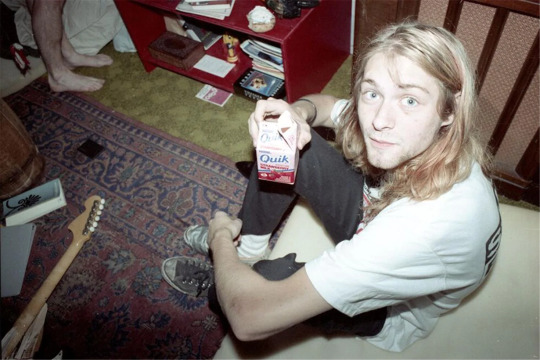
Cobain in 1989 when Nirvana played Boston
Over the years, I’ve continued to enjoy Nirvana live and compilation albums and I’ve also continued to follow both Kris Novoselic and Dave Grohl’s respective musical journey as well. The fact that there were only 3 studio albums from Nirvana has only fed my interest in seeking out rarities and live bootlegs. We can only imagine what would have happened for Cobain as a musician and creative force if he had lived. But at least he left us so many gifts to remember him by: Bleach, Nevermind, In Utero and MTV Unplugged to name just a few!
Here is that MTV News report from April 8, 1994 where Kurt Loder broke the news.
4 notes
·
View notes
Text
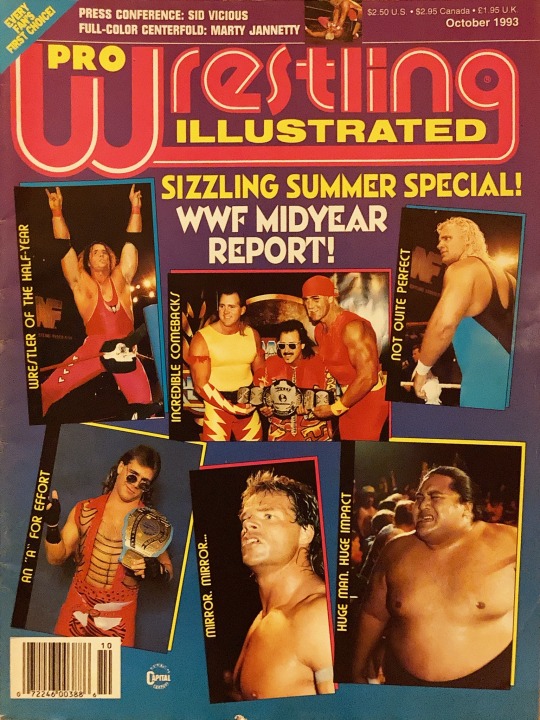
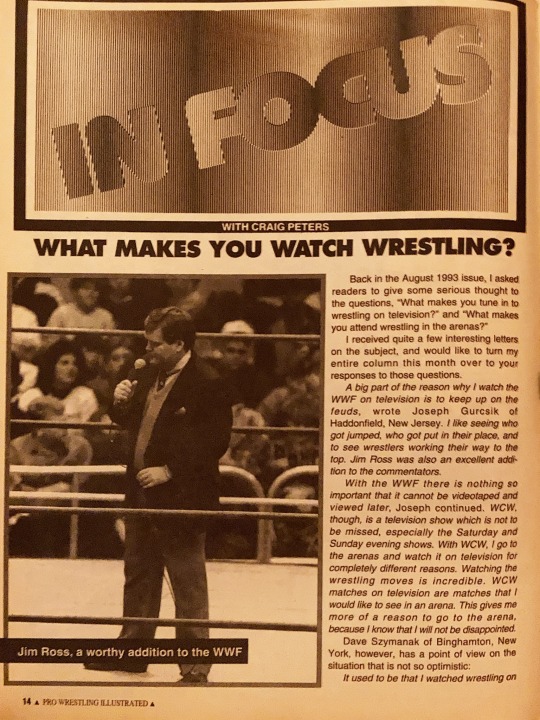
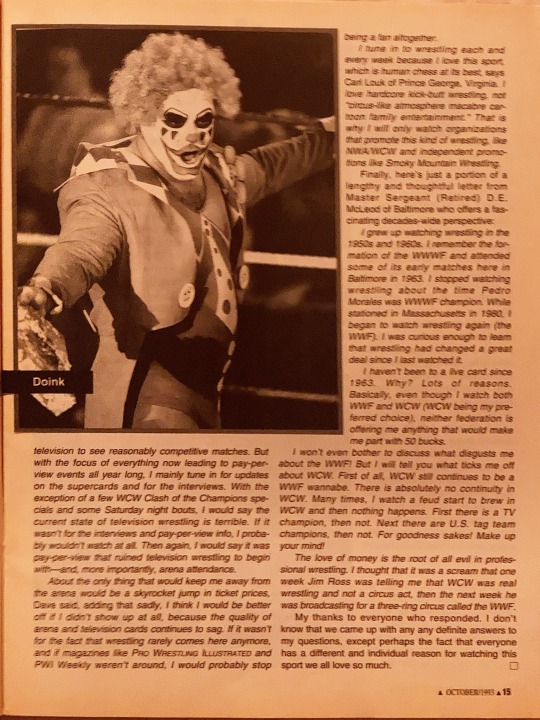
Pro Wrestling Illustrated: October 1993
IN FOCUS
WITH CRAIG PETERS
WHAT MAKES YOU WATCH WRESTLING?
[Jim Ross, a worthy addition to the WWF]
Back in the August 1993 issue, I asked readers to give some serious thought to the questions, “What makes you tune in to wrestling on television?” and “What makes you attend wrestling in the arenas?”
I received quite a few interesting letters on the subject, and would like to turn my entire column this month over to your responses to those questions.
A big part of the reason why I watch the WWF television is to keep up on the feuds, wrote Joseph Gurcsik of Haddonfield, New Jersey. I like seeing who got jumped, who got put in their place and to see wrestlers working their way to the top. Jim Ross was also an excellent addition to the commentators.
With the WWF there is nothing so important that it cannont be videotaped and viewed later, Joseph continued. WCW, though, is a television show which is not to be missed, especially the Saturday and Sunday evening shows. With WCW, I go to the arenas and watch it on television for completely different reasons. Watching the wrestling moves is incredible. WCW matches on television are matches that I would like to see in an arena. This gives me more of a reason to go to the arena, because I know that I will not be disappointed.
Dave Szymanak of Binghamton, New York, however, has a point of view on the situation that is not so optimistic:
It used to be that I watched wrestling on television to see reasonably competitive matches. But with the focus on everything now leading to pay-per-view events all year long, I mainly tune in for updates on the supercards and for the interviews. With the exception of a few WCW Clash of the Champions specials and some Saturday night bouts, I would say the current state of television wrestling is terrible. If it wasn’t for the interviews and pay-per-view info, I probably wouldn’t watch at all. Then again, I would say it was pay-per-view that ruined television wrestling to begin with–and, more importantly, arena attendance.
About the only thing that would keep me away from the arena would be a skyrocket jump in ticket prices, Dave said, adding that sadly, I think I would be better off id i didn’t show up at all, because the quality of arena and television cards continues to sag. If it wasn’t for the fact that wrestling rarely comes here anymore, and if magazines like PRO WRESTLING ILLUSTRATED and PWI Weekly weren’t around, I would probably stop being a fan altogether.
[Doink]
I tune in to wrestling each and every week because I love this sport, which is human chess at its best, says Carl Louk of Prince George, Virginia. I love hardcore kick-butt wrestling, not circus-like atmosphere macabre cartoon family entertainment.” That is why I will only watch organizations that promote this kind of wrestling, like NWA,WCW and independent promotions like Smoky Mountain Wrestling.
Finally, here’s just a portion of a lengthy and thoughtful letter from Master Sergeant (Retired) D.E. McLeod of Baltimore who offers a fascinating decade-wide perspective:
I grew up watching wrestling in the 1950s and 1960s. I remember the formation of the WWWF and attended some of its early matches here in Baltimore in 1963. I stopped watching wrestling about the time Pedro Morales was WWWF champion. While stationed in Massachusetts in 1980, I began to watch wrestling again (the WWF). I was curious enough to learn that wrestling had changed a great deal since I last watched it.
I haven't been to a live card since 1963. Why? Lots of reasons. Basically, even though I watch both WWF and WCW (WCW being my preferred choice), neither federation is offering me anything that would make me part with 50 bucks.
I won’t even bother to discuss what disgust me about the WWF! But I will tell you what ticks me off about WCW. First of all, WCW still continues to be a WWF wannabe. There is absolutely no continuity in WCW. Many times, I watch a feud start to brew in WCW and then nothing happens. First there is a TV champion, then not. Next there are U.S. tag team champions, then not. For goodness sakes! Make up your mind!The love of money is the root of all evil in professional wrestling. I thought that it was a scream that one week Jim Ross was telling me that WCW was real wrestling and not a circus act, then the next week he was broadcasting for a three ring circus called the WWF.
My thanks to everyone who responded. I don’t know that we came up with any definite answers to my questions, except perhaps the fact that everyone has a different and individual reason for watching this sport we all love so much.
#hi guys not to be silly but I’d love if u could tell me why u watch wrestling#like if you want you can message me or put it in the comments#but I’d love to read :3#cause I love hearing people’s thoughts#anyways the tags ugh#PWI#pro wrestling illustrated#magazine scan#magazine transcript#PWI 1990s#1990s#1993
4 notes
·
View notes
Text
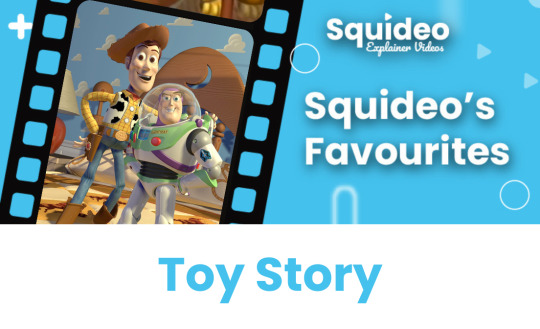
Squideo’s Favourites: Toy Story
Pixar Animation Studios arrived with a bang when its first feature-length film, Toy Story, was released in 1995. What would follow was a franchise beloved by children, spawning multiple spin-offs, theme park rides, video games and merchandise. Nominated for 4 Academy Awards, Toy Story is now considered one of the best animated films of all time.
Toy Story is credited with opening up the world of 3D computer animated films, which still rules the industry to this day. With the sponsorship of Disney, Pixar used this technology to create a film that visually stood apart from everything else at the box office and helped complete Pixar’s journey from a small computer division at Lucasfilm to an award-winning studio that has produced some of the best animated films of the past thirty years.
We’re diving into the production behind this animated film, exploring the style and techniques which came together to create this compelling story. In the meantime, if you have an idea for an animated video of your own get in touch with the Squideo team.
Creating a Story
To any fan of animation, Buzz Lightyear and Woody are well-known characters. Yet without Tinny, who reached nowhere near as much fame, they may never have graced our screens.
Pixar Animation Studios had produced a number of animated shorts before it ventured into feature length production, starting with Luxo Jr. (which introduced Pixar’s mascot). Red’s Dream followed, but it was Tin Toy that caught Disney’s attention. Financed by Steve Jobs, Tin Toy was a five-minute short created and directed by John Lasseter. Seen through the perspective of a toy running away from a destructive infant, Tin Toy laid down the groundwork for Toy Story – another Lasseter creation.
Disney had only recently allowed films to be made outside its own production company, starting with Tim Burton’s Nightmare Before Christmas (1993).
In a 2011 interview with Entertainment Weekly, [John Lasseter] said: "Disney kept trying to hire me back after each of the short films I had made. I kept saying, 'Let me make a film for you up here.” They always said, 'No, a Disney animated film will always be made at Disney.' They had no interest in doing an outside project." Lasseter continued: "What changed their mind was Tim Burton. Tim and I went to college together, and he had developed a feature idea called 'The Nightmare Before Christmas.' He went on to become a successful live-action director and was trying to buy 'Nightmare' back from Disney. And they said, 'Why don’t you just make it for us?' That opened the door for Disney to think of these niche animated films that could be done. They said, 'Okay, we’re willing to talk with you. We’ve got puppet animation going [with Tim Burton] and now we’ll be willing to develop the computer animation.' They said to come back when we had an idea. So we started thinking…" John Lasseter
youtube
3D computer animation developed alongside CGI in the 1970s, but a fully created computer animation television show or film didn’t debut until the 1990s. Yet animation companies, including Disney, had already played with the new technology before then. The Great Mouse Detective (1988) was the first Disney film to extensively use CGI: creating a two-minute sequence which was heavily promoted in the film’s marketing.
Their CGI was developed in cooperation with Pixar, the two companies coming together to make CAPS, the Computer Animation Production System which was relied upon heavily during the Disney Renaissance.
The technology was new, which put giant animation studios at a disadvantage. Their artists were trained in 2D animation techniques, leaving a void for computer companies who had the expertise to utilise this new technology.

Animation Style
The use of this new technology resulted in a film that looked vastly different from everything that predated it. Not only did 3D computer animation provide greater realism, but the independence of these early animators also meant they were not constrained by an existing “style” favoured by a company.
To this day, animated characters start life at Disney as 2D concept drawings which influences the style once it is converted to 3D. Pixar on the other hand is at home in that format, and their animators create greater complexities and detailed textures in their work.
“There are differences between Pixar and Disney. If you reduced Pixar to a phrase it would be: ‘Wouldn’t it be cool if?’ Like if a kid was looking at their toy: What if the toy could talk? All their films are like this. If you reduced the Disney films it would be: ‘Once upon a time…’.” Glen Keane
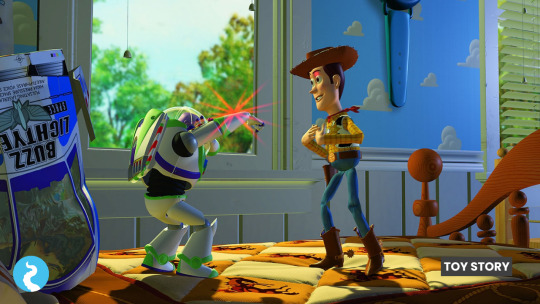
The filmmakers designed the minor characters using memories of their childhood toys, but the two leads were a different story. Woody and Buzz Lightyear went through several redesigns, along with the addition and removal of multiple human characters. Thankfully, Disney brought Joss Whedon onboard as a co-writer after reviewing the initial drafts. Now best known for directing and writing Marvel’s The Avengers (2012), Firefly (2002) and Buffy the Vampire Slayer (1997-2003), Toy Story was his first hit for which Whedon shared an Academy Award for Best Original Screenplay.
Because 3D computer animation was so new, even the lead actors didn’t know what the film would look like. Tom Hanks, who voiced Woody, said: “The shading and the light and its starting to look crisp and clean it looks surreal and real, it had a really neat 3-D quality to it without that fuzzy eyeball stuff.”
While Tim Allen, who voiced Buzz Lightyear, said: “When I first saw it I thought, 'I don't know if kids are gonna buy this, adults especially not, it's too high tech, it looks too much like a video game. And they got the second generation, third generation, it started looking slicker and slicker and then they finally finished with a shot of the soldiers going 'one, two, three, let's go!' and they went down the rope, wow! What a view!”
youtube
Pixar’s software was key to the animation of Toy Story. From RenderMan to Menv, the latter of which has since been replaced at Pixar by Presto, it took over 400 computer models to make the film. And it was worth every second of development. Toy Story showed the world that – not only was Pixar the new kid on the animation block – but that they also held the key to the future of animated film.
Get Started With Your Video
Inspired to create a unique animated video of your own? Watch the video below to get a better understanding of how Squideo can help promote your business, then get in touch with us to find out more!
youtube
#toy story#pixar animation studios#pixar#disney#walt disney animation studios#3d computer animation#3d animation#computer animation#buzz lightyear#woody#tin toy#tinny#steve jobs#john lasseter#tim burton#nightmare before christmas#CAPS#computer animation production system#glen keane#joss whedon#tom hanks#tim allen#renderman#menv#presto#youtube#2d animation#animation#small business on tumblr#small business
3 notes
·
View notes